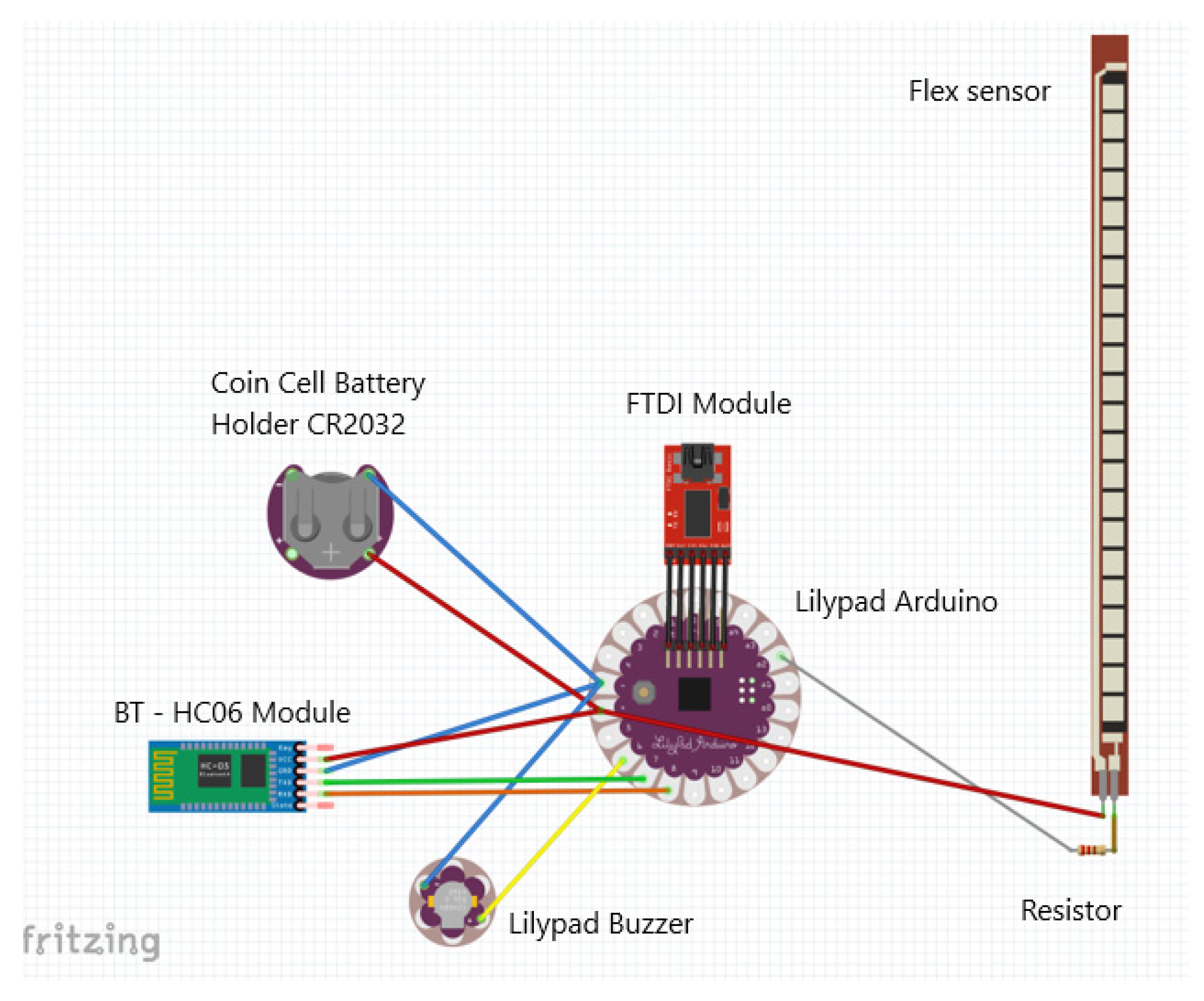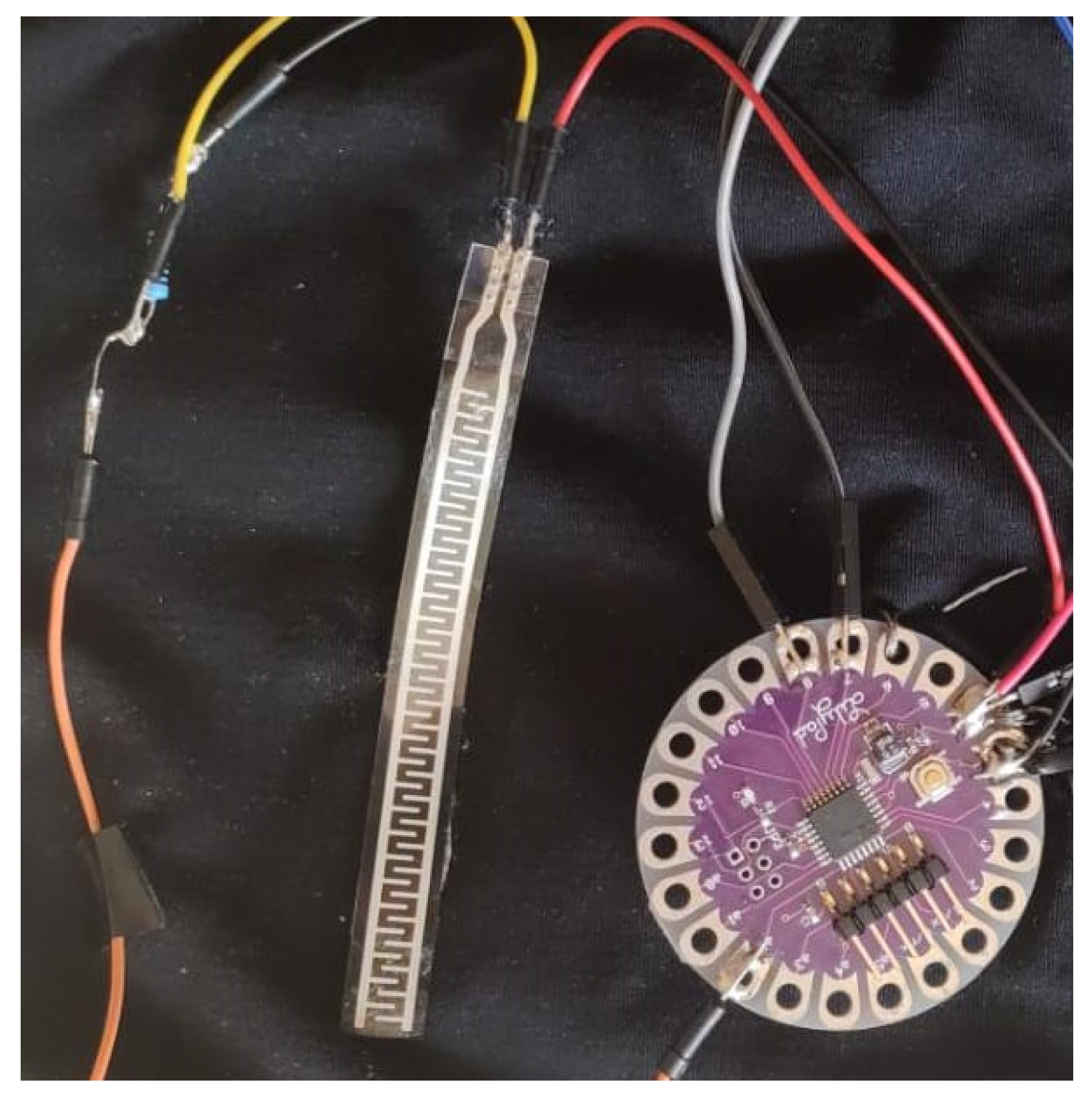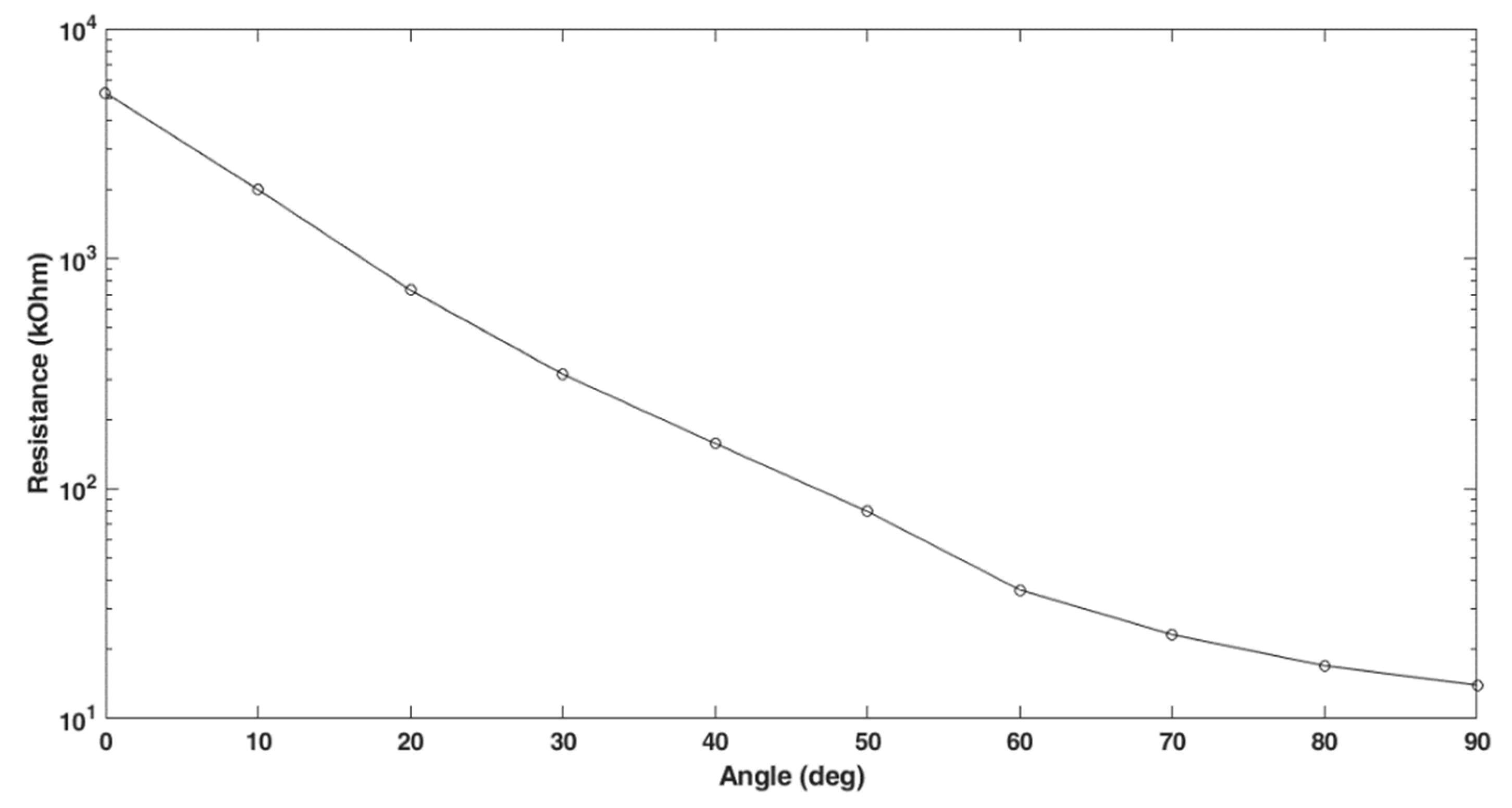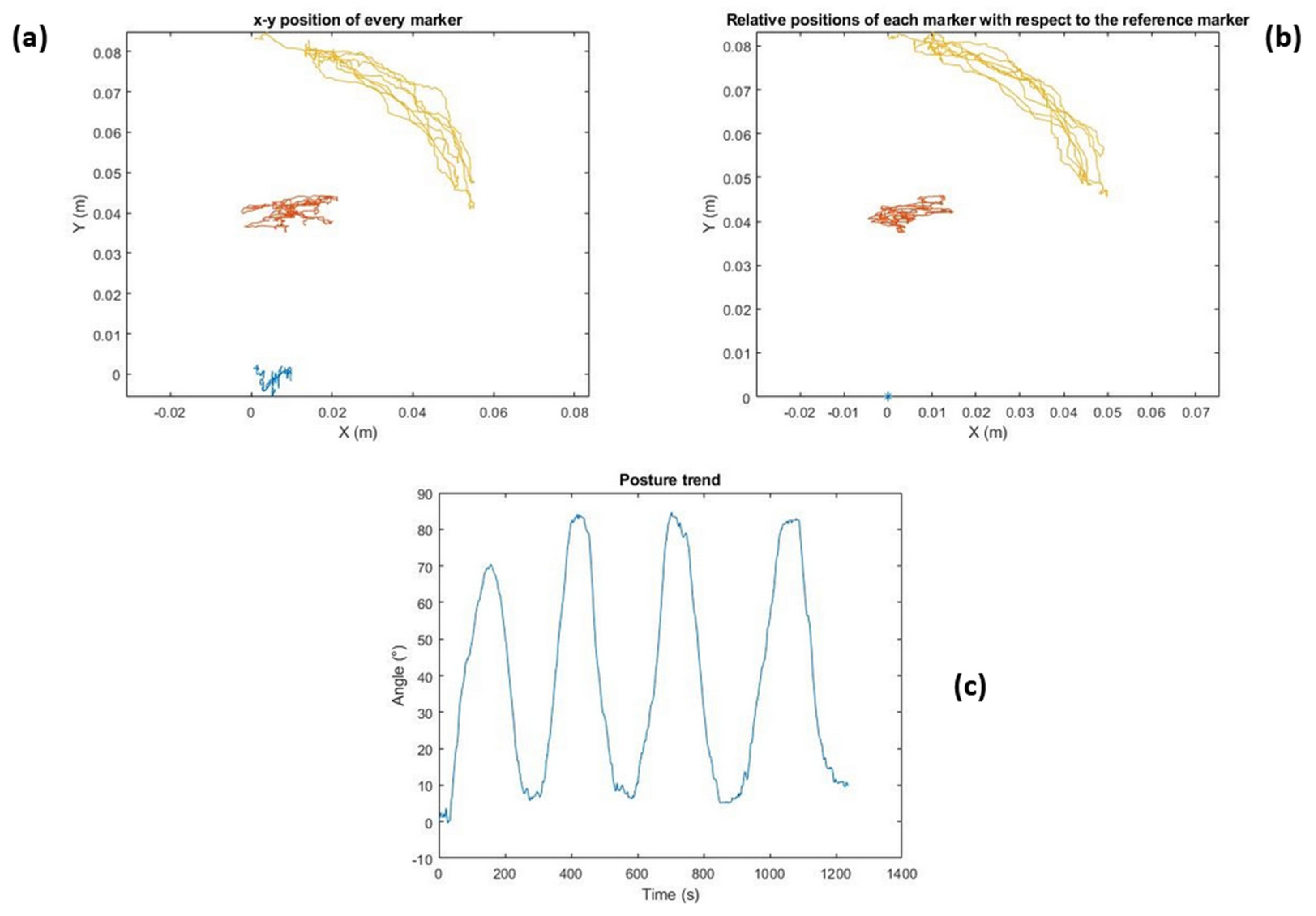Low-Cost Wireless Wearable System for Posture Monitoring
Abstract
:1. Introduction
2. Materials and Methods
3. Results
4. Conclusions
Author Contributions
Funding
Conflicts of Interest
References
- Shi, Q.; Dong, B.; He, T.; Sun, Z.; Zhu, J.; Zhang, Z.; Lee, C. Progress in Wearable Electronics/Photonics—Moving toward the Era of Artificial Intelligence and Internet of Things. InfoMat 2020, 2, 1131–1162. [Google Scholar] [CrossRef]
- Heo, J.S.; Eom, J.; Kim, Y.-H.; Park, S.K. Recent Progress of Textile-Based Wearable Electronics: A Comprehensive Review of Materials, Devices, and Applications. Small 2018, 14, 1703034. [Google Scholar] [CrossRef] [PubMed]
- Song, Y.; Min, J.; Yu, Y.; Wang, H.; Yang, Y.; Zhang, H.; Gao, W. Wireless Battery-Free Wearable Sweat Sensor Powered by Human Motion. Sci. Adv. 2020, 6, eaay9842. [Google Scholar] [CrossRef] [PubMed]
- Seneviratne, S.; Hu, Y.; Nguyen, T.; Lan, G.; Khalifa, S.; Thilakarathna, K.; Hassan, M.; Seneviratne, A. A Survey of Wearable Devices and Challenges. IEEE Commun. Surv. Tutor. 2017, 19, 2573–2620. [Google Scholar] [CrossRef]
- Sakuma, K. Flexible, Wearable, and Stretchable Electronics, 1st ed.; Iniewski, K., Ed.; CRC Press: Boca Raton, FL, USA, 2020. [Google Scholar]
- Ma, Z.; Li, S.; Wang, H.; Cheng, W.; Li, Y.; Pan, L.; Shi, Y. Advanced Electronic Skin Devices for Healthcare Applications. J. Mater. Chem. B 2019, 7, 173–197. [Google Scholar] [CrossRef] [PubMed]
- Rosa, B.M.G.; Yang, G.Z. A Flexible Wearable Device for Measurement of Cardiac, Electrodermal, and Motion Parameters in Mental Healthcare Applications. IEEE J. Biomed. Health Inform. 2019, 23, 2276–2285. [Google Scholar] [CrossRef] [PubMed]
- Will, J.S.; Bury, D.C.; Miller, J.A. Mechanical Low Back Pain. Am. Fam. Physician 2018, 98, 421–428. [Google Scholar] [PubMed]
- Lou, E.; Bazzarelli, M.; Hill, D.; Durdle, N. A Low Power Accelerometer Used to Improve Posture. In Proceedings of the Canadian Conference on Electrical and Computer Engineering 2001. Conference Proceedings (Cat. No.01TH8555), Toronto, ON, Canada, 13–16 May 2001; IEEE: Toronto, ON, Canada, 2001; Volume 2, pp. 1385–1389. [Google Scholar] [CrossRef] [Green Version]
- Sathyanarayana, S.; Satzoda, R.K.; Sathyanarayana, S.; Thambipillai, S. Vision-Based Patient Monitoring: A Comprehensive Review of Algorithms and Technologies. J. Ambient. Intell. Humaniz. Comput. 2018, 9, 225–251. [Google Scholar] [CrossRef]
- Taieb-Maimon, M.; Cwikel, J.; Shapira, B.; Orenstein, I. The Effectiveness of a Training Method Using Self-Modeling Webcam Photos for Reducing Musculoskeletal Risk among Office Workers Using Computers. Appl. Ergon. 2012, 43, 376–385. [Google Scholar] [CrossRef] [PubMed]
- Zhang, J.; Zhang, H.; Dong, C.; Huang, F.; Liu, Q.; Song, A. Architecture and Design of a Wearable Robotic System for Body Posture Monitoring, Correction, and Rehabilitation Assist. Int. J. Soc. Robot. 2019, 11, 423–436. [Google Scholar] [CrossRef]
- Tlili, F.; Haddad, R.; Bouallegue, R.; Mezghani, N. A Real-Time Posture Monitoring System Towards Bad Posture Detection. Wirel. Pers. Commun. 2021, 120, 1207–1227. [Google Scholar] [CrossRef]
- Rodriguez, A.; Rabunal, J.R.; Pazos, A.; Rodriguez Sotillo, A.; Ezquerra, N. Wearable Postural Control System for Low Back Pain Therapy. IEEE Trans. Instrum. Meas. 2021, 70, 1–10. [Google Scholar] [CrossRef]
- Caviedes, J.E.; Li, B.; Jammula, V.C. Wearable Sensor Array Design for Spine Posture Monitoring During Exercise Incorporating Biofeedback. IEEE Trans. Biomed. Eng. 2020, 67, 2828–2838. [Google Scholar] [CrossRef] [PubMed]
- Bootsman, R.; Markopoulos, P.; Qi, Q.; Wang, Q.; Timmermans, A.A. Wearable Technology for Posture Monitoring at the Workplace. Int. J. Hum.-Comput. Stud. 2019, 132, 99–111. [Google Scholar] [CrossRef]
- Sardini, E.; Serpelloni, M.; Pasqui, V. Wireless Wearable T-Shirt for Posture Monitoring During Rehabilitation Exercises. IEEE Trans. Instrum. Meas. 2015, 64, 439–448. [Google Scholar] [CrossRef]
- García Patiño, A.; Khoshnam, M.; Menon, C. Wearable Device to Monitor Back Movements Using an Inductive Textile Sensor. Sensors 2020, 20, 905. [Google Scholar] [CrossRef] [Green Version]
- Baijot, M.; Puers, R.; Kraft, M. Monitoring Lower Back Activity in Daily Life Using Small Unintrusive Sensors and Wearable Electronics in the Context of Rheumatic and Musculoskeletal Diseases. Sensors 2021, 21, 6362. [Google Scholar] [CrossRef]
- Wu, Y.; Yan, T.; Zhang, K.; Pan, Z. Flexible and Anisotropic Strain Sensors Based on Highly Aligned Carbon Fiber Membrane for Exercise Monitoring. Adv. Mater. Technol. 2021, 2100643. [Google Scholar] [CrossRef]
- Papi, E.; Koh, W.S.; McGregor, A.H. Wearable Technology for Spine Movement Assessment: A Systematic Review. J. Biomech. 2017, 64, 186–197. [Google Scholar] [CrossRef]
- ATmega328. Available online: https://www.microchip.com/en-us/product/ATmega328 (accessed on 25 September 2021).
- USB to Serial Breakout-FT232RL. Available online: https://www.sparkfun.com/products/12731 (accessed on 25 September 2021).
- Arduino and Bluetooth Module HC-06. Available online: https://www.aranacorp.com/en/arduino-and-bluetooth-module-hc-06/ (accessed on 25 September 2021).
- Saggio, G.; Orengo, G. Flex Sensor Characterization against Shape and Curvature Changes. Sens. Actuators A Phys. 2018, 273, 221–231. [Google Scholar] [CrossRef]
- Tracker Video Analysis and Modeling Tool. Available online: https://physlets.org/tracker/ (accessed on 25 September 2021).






Publisher’s Note: MDPI stays neutral with regard to jurisdictional claims in published maps and institutional affiliations. |
© 2021 by the authors. Licensee MDPI, Basel, Switzerland. This article is an open access article distributed under the terms and conditions of the Creative Commons Attribution (CC BY) license (https://creativecommons.org/licenses/by/4.0/).
Share and Cite
Ardito, M.; Mascolo, F.; Valentini, M.; Dell’Olio, F. Low-Cost Wireless Wearable System for Posture Monitoring. Electronics 2021, 10, 2569. https://doi.org/10.3390/electronics10212569
Ardito M, Mascolo F, Valentini M, Dell’Olio F. Low-Cost Wireless Wearable System for Posture Monitoring. Electronics. 2021; 10(21):2569. https://doi.org/10.3390/electronics10212569
Chicago/Turabian StyleArdito, Marilda, Fabiana Mascolo, Martina Valentini, and Francesco Dell’Olio. 2021. "Low-Cost Wireless Wearable System for Posture Monitoring" Electronics 10, no. 21: 2569. https://doi.org/10.3390/electronics10212569
APA StyleArdito, M., Mascolo, F., Valentini, M., & Dell’Olio, F. (2021). Low-Cost Wireless Wearable System for Posture Monitoring. Electronics, 10(21), 2569. https://doi.org/10.3390/electronics10212569






